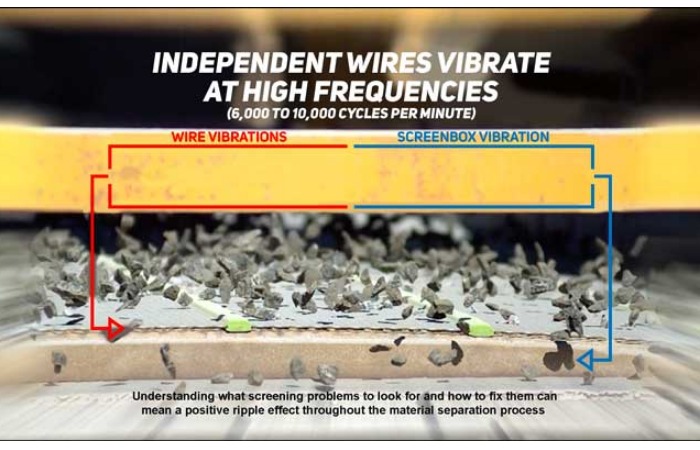
Better Screening is Free Crushing
Understanding what screening problems to look for and how to fix them can mean a positive ripple effect throughout the material separation process. A combination of a proactive maintenance plan and the addition of high-performance screen media makes remedying issues and improving efficiency even easier.
Photo courtesy: MAJOR
At First Look
Operations continuously look to improve their bottom line by decreasing the cost per ton. Plant managers must address how much can be produced with a given set of screens and by reducing cost factors tied to poor performance, such as machine downtime or screen media change-outs.
First, producers should work with an expert to conduct a screening performance assessment to see the complete picture of the operation. This should include an evaluation of the process and any direct screen media issues, but also the screen setup, the machine condition and how it affects performance. Use a vibration analysis tool to look for abnormalities that may need to be addressed and cant be easily seen with the human eye. Also, listen to the deck while it is running to reveal things like loose media, clamp bars or broken wires. Listen for abnormalities or metallic sounds.
Next, producers should examine the crusher feed belt coming off of the screen box to identify issues that could lead to a bottleneck. Improving screening efficiency directly in front of this point has effects throughout the entire operation in both directions.
A visual check or a belt cut of the crusher feed belt is often enough to see if there is saleable rock that is being sent to the crusher as carryover because the deck capacity is exceeded. This is caused by blinding, pegging, poor open area, non-ideal vibration setup or the wrong screen media setup.
Lastly, look at the scrap pile ” also known as the boneyard ” of used screen media. Inspecting the underside of the spent screens is an effective way to diagnose installation challenges. Look for black markings on the underside of the screen media that show the panels have moved and rubbed against machine supports, meaning they werent fixed in place like they should have been. This primarily causes wear but can also lead to blinding, pegging and inefficiency. Signs of blinding, pegging or breakage in the used screen media pile are also a good way to quickly identify which machines and decks need attention.
Addressing Issues
Better screening is free crushing is a statement sometimes heard in the industry. There are many ways to interpret the saying, but it boils down to how an efficient screen box lessens the load on a crusher by sizing material correctly.
Many screening issues can be addressed with a change in screen media. From traditional woven wire to polyurethane to high-performance screen media, there is no shortage of different styles of screens. The choices can seem daunting; oftentimes one type works for specific situations or works best through a combination of different types. An exception is some styles that use advanced engineering to address screening issues with just variations of a single type of media.
High-vibration screen media is one such option. This advanced screen media is made up of independent wires bonded with polyurethane strips. The wires vibrate independently to add to a screen boxs existing vibration, speeding up material separation and passing.
Screen media options that incorporate this design permit an increased screening action which helps to spread the material over the entire screens surface area on all decks, but most importantly accelerates the stratification process. This effect causes rocks of different sizes to separate with fine material sinking towards the screen surface and bigger rocks rising to the top of the material bed. Faster stratification increases the capacity of the deck and allows for a cleaner cut.
The movement of wires helps to virtually eliminate near-size pegging on the top decks and fine material blinding and clogging on the bottom decks, resulting in a higher-quality end product. In addition to considering a change of screen media, ensure tensioned screens are installed properly and that surrounding equipment is operating correctly. Once the process is running productively and smoothly, operations should do what they can to maintain that performance. Develop a preventative maintenance plan that includes vibration analysis tests at regular intervals to identify changes that may point to problems.
Smooth Screening
Remember that screen media will wear out over time, but it should not have to be replaced because it is broken, pegged or blinded. Work with a dealer or screen media manufacturer to determine the best screen media options for your application, and create a proactive maintenance plan to maintain optimum results.
ABOUT THE AUTHOR:
The article is authored by Lars Br¤unling, Director of Product Technology, MAJOR.


 +91-22-24193000
+91-22-24193000 Subscriber@ASAPPinfoGlobal.com
Subscriber@ASAPPinfoGlobal.com